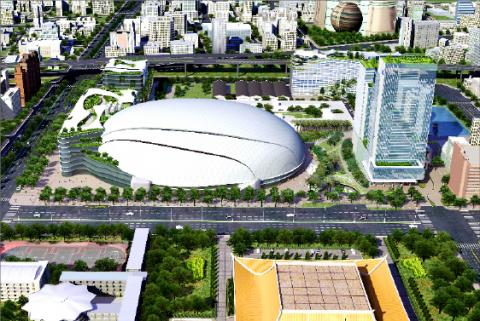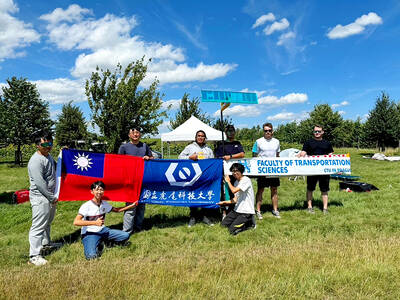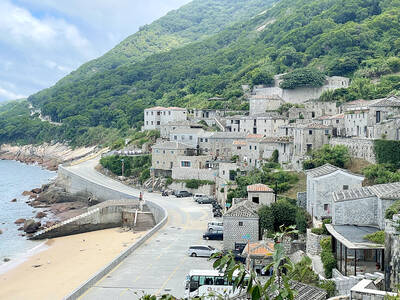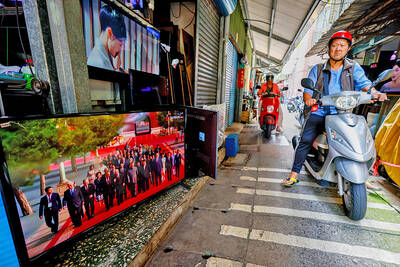The long-stalled construction project for the Taipei Dome yesterday passed Taipei City’s urban design review amid protests over the project’s possible impact on local traffic and overall environment.
The proposed site of the complex, which includes a 40,000-seat indoor stadium with surrounding shopping and residential districts, is located at the corner of Zhongxiao E and Guangfu S roads. Construction is scheduled to start in July if it passes the environmental impact assessment early next year.
The Urban Design Review Committee’s decision to approve the project was met with strong protests from a group of environmentalists and local residents who rushed into the closed-door meeting and clashed with police.

PHOTO COURTESY OF THE TAIPEI CITY GOVERNMENT DEPARTMENT OF URBAN
“Several hundred old trees at the historic Songshan Tobacco Factory were removed because of the project and local residents have lost a place to exercise and relax,” said Yu Yi (游藝), a member of a civic group that calls for the preservation of the factory site. “The city government is profiting enterprises by approving the project.”
Calls by protesters on the city government to reject the project and annul the build-operate-transfer contract with the Farglory Group failed to prevent the review committee from approving the project, which was originally scheduled for completion this year.
Farglory chairman Chao Teng-hsiung (趙藤雄), who attended the committee meeting, rejected the protesters’ claim that the building would have a negative impact on the environment, adding that the complex would not pose a serious threat to the environment as it has gone through “the strictest reviews.”
Ting Yu-chun (丁育群), commissioner of the city’s Urban -Development Department and review committee chairman, said that even if the project were approved, the Farglory Group would still be required to submit a report on traffic control measures.
The group signed the contract with the city government in 2006 and plans to invest more than NT$23 billion (US$700 million) in the complex.
Since then, ongoing protests from environmentalists and local residents have stalled the review process and the group subsequently agreed to reduce the size of the complex from 590,000m2 to 555,000m2.
Taipei Mayor Hau Lung-bin (郝龍斌) said yesterday the project had followed all necessary administrative processes over the years and that the city’s review committee had approved it through a fair and transparent mechanism.

The Chinese military has built landing bridge ships designed to expand its amphibious options for a potential assault on Taiwan, but their combat effectiveness is limited due to their high vulnerability, a defense expert said in an analysis published on Monday. Shen Ming-shih (沈明室), a research fellow at the Institute for National Defense and Security Research, said that the deployment of such vessels as part of the Chinese People’s Liberation Army (PLA) Navy’s East Sea Fleet signals a strong focus on Taiwan. However, the ships are highly vulnerable to precision strikes, which means they could be destroyed before they achieve their intended

The Taiwan Experience Education Program (TEEP) has funded short-term internships in Taiwan for more than 4,500 young people from more than 40 countries since 2015, with the goal of attracting and retaining international talent, the Ministry of Education said yesterday. Fifty-five colleges launched 514 projects this year, including in fields such as semiconductors, artificial intelligence, medicine and biotechnology, green energy, and sustainability, it said. The program provides research and practical internships in Taiwan for two to six months, and offers cultural exchange and networking opportunities, the ministry said. For example, National Formosa University’s Embedded System and Autopilot Laboratory developed two solar-powered drones in

GLOBAL: Although Matsu has limited capacity for large numbers of domestic tourists, it would be a great high-end destination for international travelers, an official said Lienchiang County’s (Matsu) unique landscape and Cold War history give it great potential to be marketed as a destination for international travelers, Tourism Administration Director General Chen Yu-hsiu (陳玉秀) said at the weekend. Tourism officials traveled to the outlying island for the Matsu Biennial, an art festival that started on Friday to celebrate Matsu’s culture, history and landscape. Travelers to Matsu, which lies about 190km northwest of Taipei, must fly or take the state-run New Taima passenger ship. However, flights are often canceled during fog season from April to June. Chen spoke about her vision to promote Matsu as a tourist attraction in

Taipei resident Mu Chu-hua caught some glimpses of China’s mighty military parade on YouTube on Wednesday. As she watched hypersonic missiles roll down Beijing’s Changan Avenue and troops march in lockstep, she did not feel like they posed a threat to Taiwan. Mu, a 69-year-old retiree, said she saw the parade as simply a way for Chinese President Xi Jinping (習近平) to “say thank you to the troops.” “I thought it was quite normal,” she said. “It was very cool.” China’s military parade commemorating the end of World War II was being watched internationally for insights into Beijing’s military advances and its show